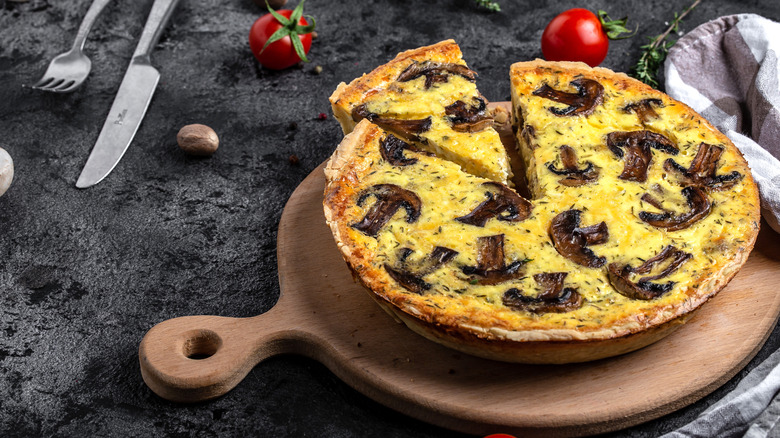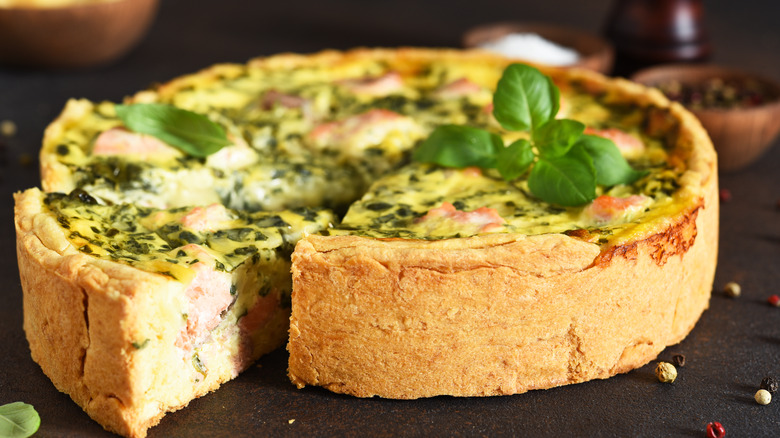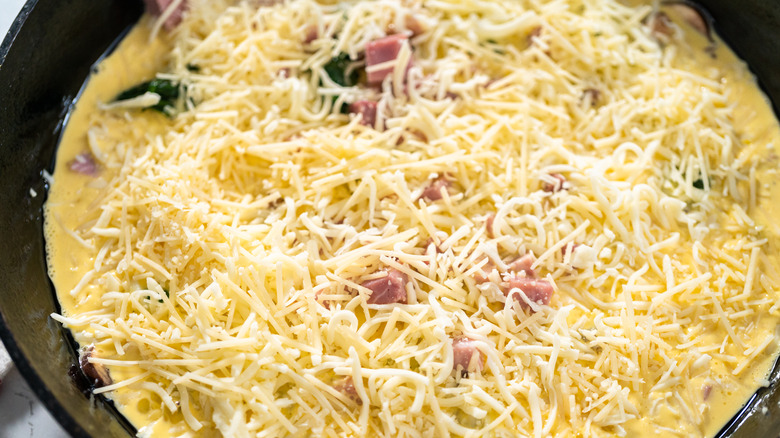The Real Difference Between A Frittata And A Quiche
Like champagne and prosecco or smoked salmon and lox, the terms quiche and frittata are sometimes used interchangeably. We can kind of see why — as both are egg-based dishes that are extremely popular for brunch (although they can really be enjoyed any time of day). The two even share similar fillings, such as spinach and broccoli, different types of cheese, mushrooms, ham, and peppers. But there are a few key differences between the two that make one distinct from the other.
If you're familiar with both, you probably already know the biggest difference between a quiche and a frittata is that a quiche has a crust and a frittata does not. Quiches are baked in pie crusts and can be thought of as a sort of breakfasty custard pie. Frittatas, on the other hand, don't have any sort of crust keeping them contained, similar to an omelet. They even come from different parts of Europe, because while the frittata is Italian, the quiche is (almost) quintessentially French.
What's in a quiche?
Quiches may be commonly associated with France, but FoodReference.com says (in hushed tones) that when the savory pie was first baked up, the area was actually the German region of Lothringen (now France's Lorraine). The word "quiche" actually comes from the German word "kuchen," or cake. Over time, quiches evolved from being made with a bread base to the shortcrust or puff pastry that is normally used today.
Experts like Martha Stewart recommend homemade crust be baked before it is used (aka blind baked), so you're not left with a soggy bottom (via Martha Stewart). Thomas Keller agrees, with Oui, Chef suggesting you bake your crust a day in advance when tackling their adaptation of Keller's Quiche Lorraine from his Bouchon cookbook.
The Kitchn offers a handy formula to follow for your basic quiche filling: 1 large egg for every ½ cup dairy. The outlet says that for a standard 9-inch pie crust, this converts to 3 eggs and 1½ cups dairy (you can use whatever you prefer — whole milk, heavy cream, half-and-half, or a mixture; just don't use anything with a lower fat percentage like skim). To this you can add any ingredients of your choice before baking. Quiche can be served warm or brought to room temperature.
Frittatas have more in common with omelets
Frittatas may look like quiches, but they actually sit closer to omelet branch of the egg family food tree. In fact, The Kitchen Project says that the frittata is seen as the omelet's Italian alter-ego. The frittata also takes on a slightly different identity in Spain, where sliced potatoes and onions are laid out in a pan and fried gently before eggs are added. Then, the whole thing is flipped to finish. The resulting dish, which can bear a striking resemblance to the frittata, is known as a Spanish tortilla (via The New York Times).
Far from the relatively big productions that quiches can be, frittatas are pretty straightforward. Often forgoing cream and milk, frittatas use a larger ratio of eggs (Jaime Oliver calls for six in his summer vegetable and goat cheese frittata recipe) whisked with salt, pepper, and any other spices. The ingredients are then added to an ovenproof frying pan, gently cooked on the stove-top, and then finished in the oven.
Levelling up your quiches and frittatas
The quiche has come a long way since it was served up simply as Lorraine — the first version of the savory pie to really grab attention in the United States in the 1950s (via The New York Times). Just about anything can be added to a quiche these days, but the most popular fillings are still different types of cheeses, from cheddar to Pecorino to gruyere to goat; veggies like greens, thinly sliced mushrooms, asparagus, potatoes, and even garlic; and meats such as sausage, bacon, and ham (via Martha Stewart).
As far as fillings go, frittatas are pretty much the same, with Epicurious suggesting egg fanatics try combos like salmon, asparagus, and fresh herbs; spinach, feta, and dill; and Italian sausage, broccoli rabe, and Parmesan. Both the quiche and frittata can be made with meat or without, giving eaters options of all kinds to enjoy from dawn to dusk.



